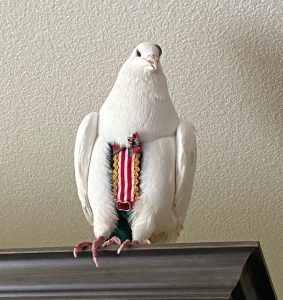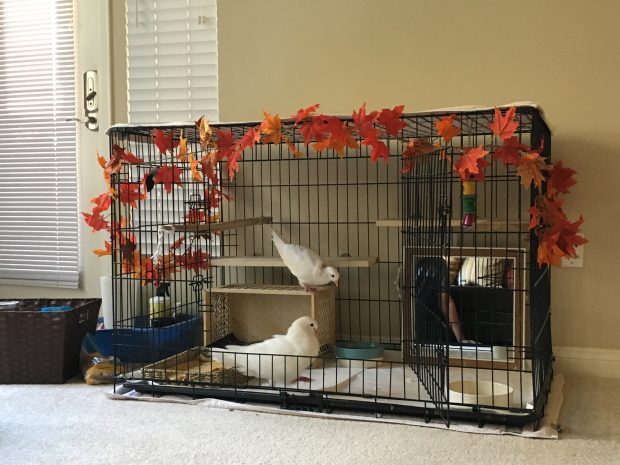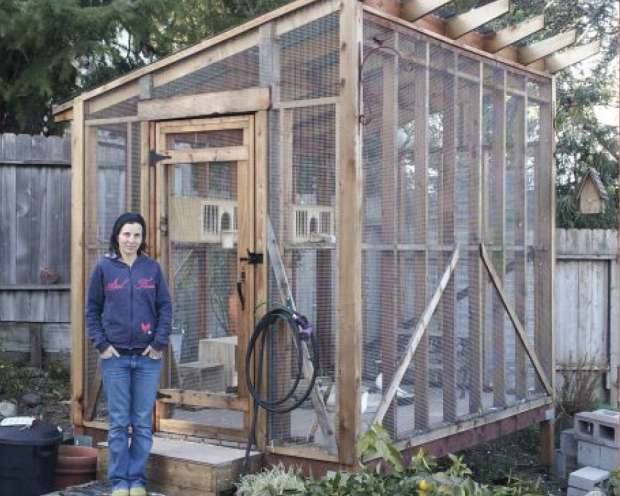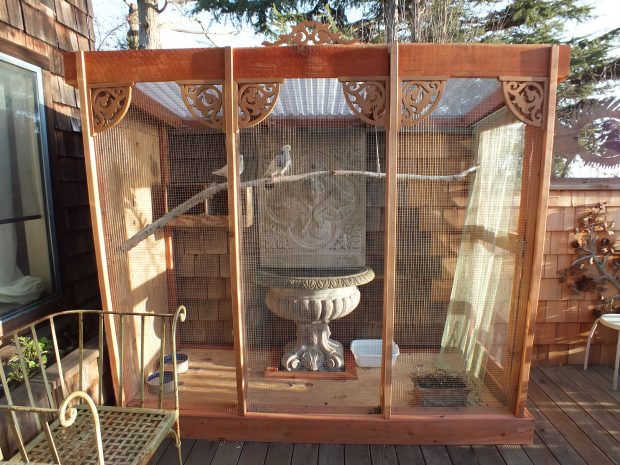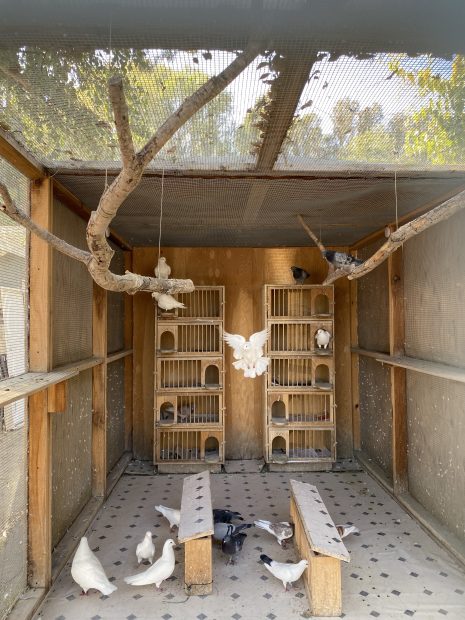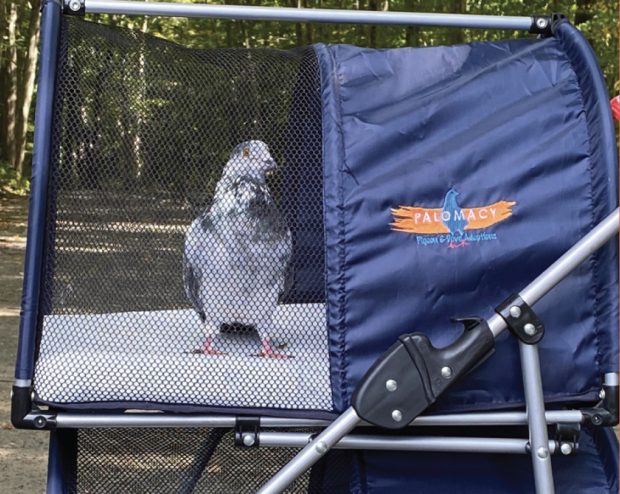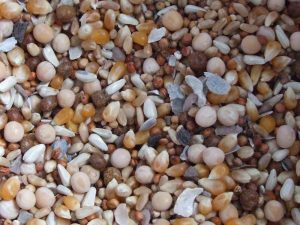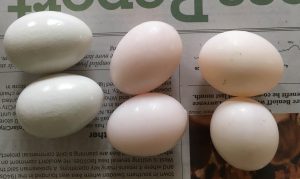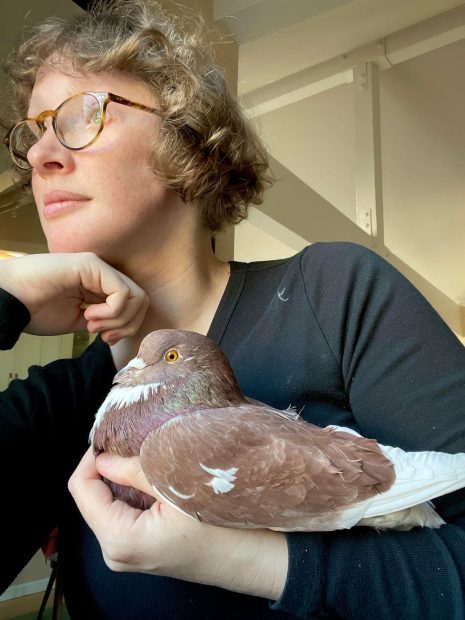
Courtney & Ray
If we had our way, there would be no pet pigeons. They would all be wild and free, not captive. Palomacy doesn’t believe that birds should be domesticated, bred and used by people for any reason. But, because people do breed, use and lose domestic unreleasable pigeons, there are a great many in need of rescue and homes. This is for those birds and the compassionate people who save their lives through rescue and adoption. There’s lots, lots more to learn about pigeons and what amazing companions they can be. Keep reading and join us in our Help Group on Facebook. Thank you for being a friend to pigeons. They are angels among us.
RESCUED OR ADOPTED INDOOR PIGEONS NEED
- an appropriate cage for their home base 36″ or more wide
- a big mirror (pigeons self-recognize & enjoy mirrors )
- fresh food and water daily (flat bottom ceramic dishes are best)
- safe, daily out-of-cage time in the house for exercise & fun
- a big flat-bottom casserole type dish for bathing
- safe access to sunshine unfiltered by glass & avian-safe full spectrum lighting
- inclusion in the family & company (yours or another pigeon)
Check out How to Care for a Rescued Pigeon & How to Choose a Good Cage for Pigeons or Doves
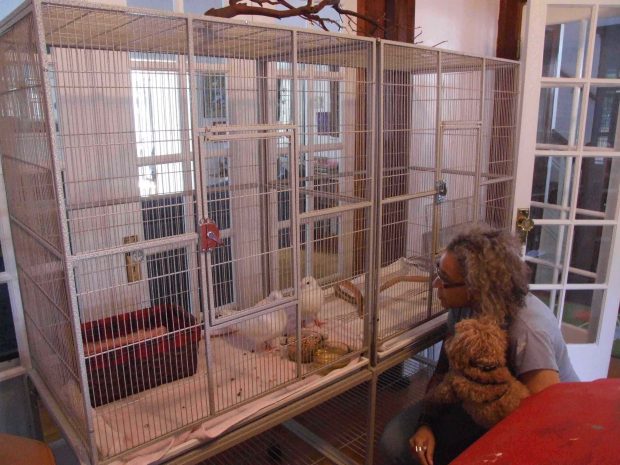
Janelle & Beep chat up Petey & Pineapple in their double-flight cage
SETTING UP AN INDOOR CAGE
Cages can only be used indoors (they are death traps outside). The bigger the cage the better and length or width are more important than height (pigeons don’t climb like parrots).
- We recommend a cage at least 42” W x 27” D x 30” H for one or two (compatible) pigeons. (Only a mated pair can live in the same cage.) If you don’t have cats or dogs in the home wanting to reach in through the bars, wide spacing like that of dog crates is fine. If you do have cats or dogs, you’ll need a cage with narrow bar-spacing (0.5” max).
- To be pigeon-friendly, the bottom should be covered with something flat and easy to clean such as vinyl or paper cage liners cut to size. Pigeons should never have to stand on a wire cage bottom. It is uncomfortable and unhealthy for their feet!
- The cage needs shelves to offer destinations to fly or hop to and hang out on. (Perches are less useful for pigeons- all you can do on a perch is stand or sit. Shelves offer more options including strutting, courting, lounging, napping, etc.)
- Include a nice big mirror (pigeons really love mirrors. It’s like TV for them, and they are proven to self-recognize) and a basket (weighted so as not to tip) or nest box. Use heavy, ceramic flat bottom, straight-sided crocks for food and water (usually found at thrift stores).
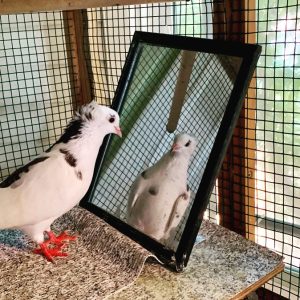
Pigeons enjoy mirrors
- Provide a casserole dish or big plant saucer for a bathtub. Healthy pigeons are very fastidious about keeping their feathers clean. They love to bathe. I leave bath water out for my pigeons all the time so they can bathe whenever they feel like it. If your pigeon is healthy but not bathing, you can inspire them to preen by misting the air above them (not directly at them). Being damp will trigger preening and should eventually lead to bathing.
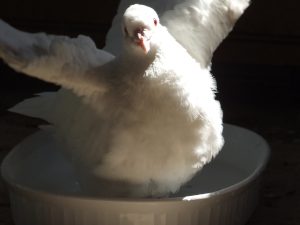
Joey celebrating bath time
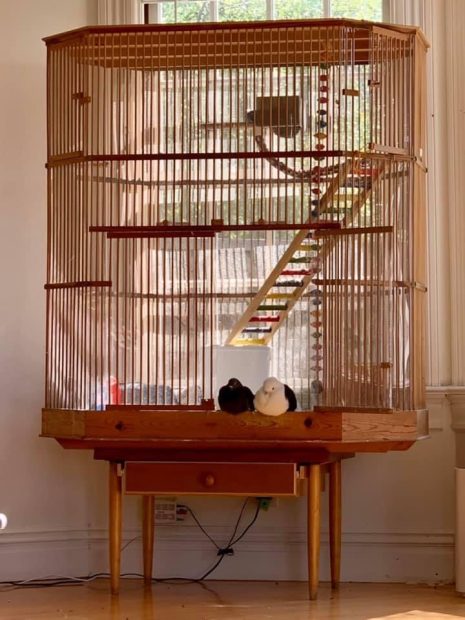
Sahra found a big, beautiful fancy cage for Muriel & Silkie
RESCUED OR ADOPTED OUTDOOR PIGEONS NEED
- a predator & rodent-proof aviary (they cannot live outside loose or in a cage) with a maximum hardware/mesh opening of .5″
- a minimum aviary size of 4’ W x 6’ L x 6’ H (bigger is better, they can’t be let out safely)
- other pigeons (single pigeons cannot be alone in an outdoor aviary)
- a big mirror (pigeons self-recognize & enjoy mirrors )
- nest boxes (one per couple) & nesting materials (e.g., pine needles)
- fresh food and water daily (flat bottom ceramic dishes are best)
- large flat-bottomed pan or dish for bathing
Check out How to Create an Aviary & How to Make the Easiest, Safest DIY Aviary
Requirements for an Aviary to be Predator & Rodent-Proof
- Build your frame tight & sturdy! Use 2 x 4s & bolt together with screws. (If you can wiggle the structure, it isn’t safe, no matter where you live nor what predator deterrents you have.)
- The entire enclosure- the 4 walls AND the bottom & top- has to be encased in .5” (or .25”) hardware cloth, each piece securely connected to & overlapping the next, all seams tight with no gap bigger than .5” square. (If there’s a gap you can fit your finger tip through, it’s not safe.)
- Or if you’re building on a cement pad & not lining the bottom with hardware cloth, be sure & bolt the frame down snugly. (You do not want mice -or anybody- getting in. Trust us.)
- Plywood/siding/roofing/flooring goes on OVER/AFTER the hardware cloth. (Rodents will chew in unless there is a hardware cloth barrier.)
- Never use chicken wire (nor bird netting) as it is a death trap for the birds confined within it.
- Build it as big as you can.
- Half should be sheltered (with roofing & siding) & half open for light & air.
- Locate it in a sunny spot (shade is easy to create) where you can see & enjoy the birds.
- Secure the door with 2 child/raccoon-proof latches, one high & one low & take care that the gaps around the door are too tight to fit your fingertip.
If you’re not sure about your cage or aviary or your design, please join & post photos to our Palomacy Help Group & we’ll happily help assess & suggest fixes if needed.
HAZARDS & RISKS
Pigeons adapt quickly to living in human households, but we must always keep their safety in mind. Their cage or aviary should be predator proof (safe haven from pets like dogs and cats, as well as outside threats like rats, hawks, raccoons, etc.).
The Ways Pet Pigeons Get Hurt
- Being injured, lost or killed while in a situation their person felt was safe but actually wasn’t. I.e. hurt/killed in unsafe aviary/cage/crate/yard while family/dog/cat is “right there”; being spooked & lost/blown away because person thinks their bird can’t/won’t fly (any pigeon with 2 wings can get airborne & blown away); being injured/killed by a predator or another pet (chicken, parrot, dog, cat).
- Being crowded. Crowded/incompatible pigeons are socially stressed, trapped in conflict/fighting, immune-suppressed & highly susceptible to illness & injury. (Learn about pigeon relationships.)
- Getting loose & lost or killed (pet pigeons do not survive long on their own, learn more). Do not take your pigeon outside unsecured, not on your shoulder, not in your yard.
- Reproductive complications related to egg-laying. It’s nearly impossible to stop a happy female pigeon from laying eggs so provide optimal nutrition, full spectrum lighting & proper use of fake eggs to minimize risks.
- Accidentally stepped on, sat on, rolled over on the couch or in bed.
- Getting entangled in any kind of loops including dangling cords, curtain pulls, etc.
- Eating foreign objects such as staples, screws, pins, paperclips, beads, earrings, cat litter, etc.
- Exposure to pollutants such as smoking, vaping, wood smoke, household chemicals, incense, candles, etc.
- Teflon-coated pans (they outgas at high temperatures and can kill birds very quickly)
- Accidents involving ceiling fans, hot stoves, open aquariums or toilets, house doors that slam shut, open windows or doors, getting stuck in narrow spaces, etc.
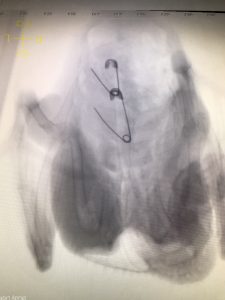
Pet pigeon Pearl found & swallowed 2 (closed) safety pins (opened by gizzard action) that required expensive surgery
We do not recommend clipping wings; clipped wings only prevent birds from flying while indoors. Clipped-wing birds can and do get airborne and lost outside all of the time! The biggest risk to a pet pigeon is getting outside and being killed by a predator before he can get back in to safety. It’s unsafe to free fly domestic pigeons and doves outside. They are easy prey for predators including hawks, ravens, gulls, cats, dogs, raccoons, etc. Your pigeon should only ever be outside in a safe carrier or a predator-proof aviary.
You don’t need to worry about pet pigeons needing heat or being cold – they are very well insulated & fine even during freezing weather. Drafts are fine, the more fresh air, the better!
DIET
Pigeons eat seeds and grains and you can buy pre-mixed blends called pigeon feed at feed stores or online. Palomacy recommends a quality blend that includes popcorn and safflower seeds. Tips for feeding:
- Feed pigeons only as much as they will eat in 24 hours. If they have food left over, let them finish that and reduce the amount you feed. If your birds have lots of food left at sunset, they are being overfed and are eating only their favorite seeds (such as high fat safflower) rather than getting balanced nutrition.
- Start with 2 tablespoons of feed per bird (probably too much) and then adjust the amount down until the amount you provide in the morning is completely consumed by evening.
- Mix a good avian vitamin & mineral supplement into their food & just a little crushed oyster shell or grit into the food, like a seasoning, for extra calcium. (Pigeons don’t need grit to digest their food. We’ve seen a lot of harm done by pigeons eating too much grit but none from lack of grit.)
Learn more about feeding here.
NO BREEDING! REPLACE REAL EGGS WITH FAKES TO PREVENT HATCHING
There are so many domestic (unreleasable) pigeons literally dying for lack of homes that it is essential to prevent breeding. Pigeons can’t be neutered nor can they be allowed to breed, so every real egg they lay MUST be removed and replaced with a fake egg (“fegg”) for hatch prevention. It’s very important to understand how to use fake eggs to prevent hatching! Just putting them in the nest isn’t enough. Learn more here.
SIGNS OF ILLNESS & GETTING MEDICAL CARE
There is a lot of misinformation about pigeons and disease. They actually pose almost no risk to humans and you’re more likely to contract a zoonotic disease from dogs or cats than you are from pigeons. Pigeon poop is easy to clean up and apple cider vinegar works great. If you want to have your pigeon out and about in the house without pooping on stuff, you can put pigeon pants (“flypers”) on them.
Avian vet care is a specialty and is very different from the treatment of dogs and cats. Signs of illness in pigeons are also unique and include:
- Sudden change in behavior or activity level
- Persistent change in color/consistency of poop
- Fluffed up, sitting on floor (not perching/flying)
- Not eating
- Hunched over
Find an avian vet here.
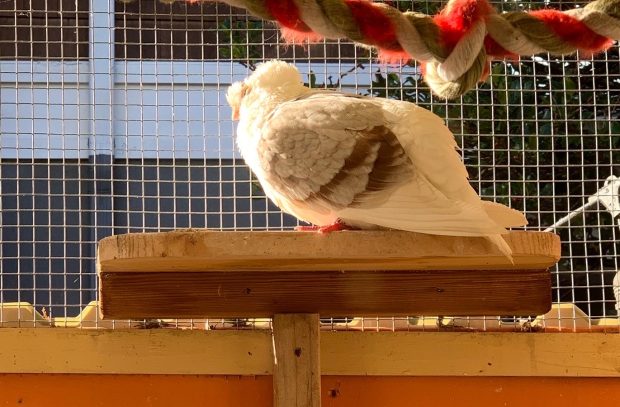
Sunny’s hunched posture indicated discomfort
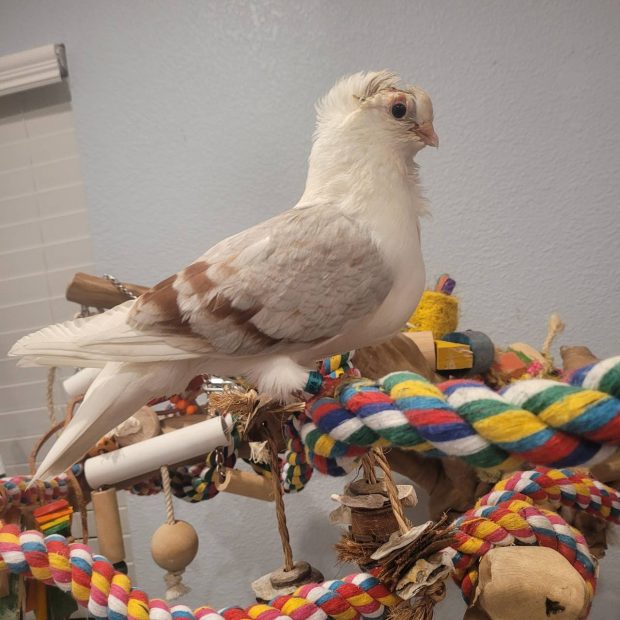
Sunny healed up, happy, hale & adopted

